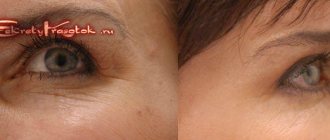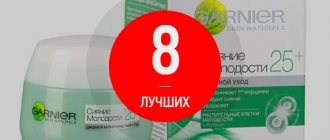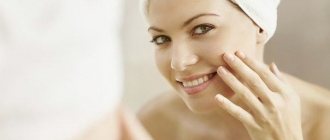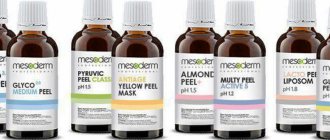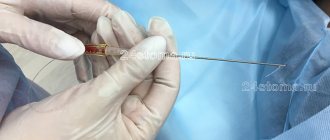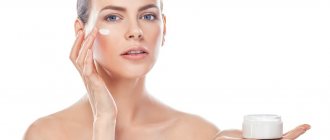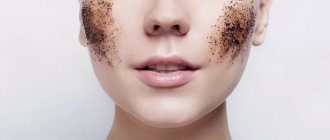Glycolic peels are the most common and popular superficial peels that can be performed by both doctors and cosmetologists and aestheticians. Of all the AHA acids, glycolic acid has the shortest molecule, containing only two carbon atoms, due to which it penetrates deeply into the skin, leads to exfoliation, and has indirect antioxidant and moisturizing effects. To reduce the aggressiveness of the acid, lactokine is added to the peeling composition. This is a one-of-a-kind active substance that contains a group of proteins isolated from milk and has a powerful anti-inflammatory effect.
Benefits of peeling
- Less traumatic and comfortable to carry out
- Does not have systemic effects
- Does not develop addiction
- Minimum rehabilitation period
- Low complication rate
- High efficiency
- Peeling can be used to correct a wide range of aesthetic problems (the optimal indication is age-related changes or prevention of aging)
Indications for peeling
- Skin withering
- Seborrheic skin
- Acne
- Hyperkeratosis
- Hyperpigmentation
- Follicular hyperkeratosis
- Ingrown hair syndrome
- Peeling can be performed as a preparation for other cosmetic procedures.
Contraindications
- Individual intolerance to peeling ingredients
- Violation of the integrity of the skin
- Active inflammatory process on the skin
- Herpes in active phase
- Severe somatic diseases
- Skin types IV–V according to Fitzpatrick
- Pregnancy, lactation
- Prolonged exposure to the sun
Home care products
- Vegelip Mesaltera Moisturizing Cream
- Prepeel Active MCP Pre-Peeling Cream
- Cleanser mousse Medic Control Pee (MCP)
Preparations required for the peeling procedure
- Cleanser mousse MCP
- Glycolic peeling Glycoliсpeel 35%, 50% or 70% (pH 1.7)
- Neutralizer
- Antioxidant mask VC-IP Mask
- Revitalizing cream Vegefarma MCP
What changes occur to the facial skin of women after 50 and 60 years of age?
At the age of about 50, women enter menopause and the production of estrogen, which is responsible for most of the processes occurring in the body, sharply decreases. The lack of these hormones impairs the absorption of nutrients. As a result, problems with general metabolism are possible, atherosclerotic changes develop in blood vessels, and circulatory processes in internal organs, muscles and skin are disrupted. Cells experience an acute shortage of oxygen and nutrients. The production of collagen and hyaluronic acid, a component that attracts and retains moisture in the skin, decreases. The skin begins to literally suffocate, its appearance deteriorates, it becomes less dense and elastic. Tissues lose volume, muscles stretch, and subcutaneous fat becomes loose. Due to all these changes, the contours of the face lose their clarity, the oval “floats”, the skin becomes flabby and sags, and deep wrinkles and folds form.
Facial contouring after 50 years is indicated to restore beauty to the skin and youth to facial features. Dense gels with hyaluronic acid restore water balance and help maintain turgor, freshness and beauty. In most cases, this procedure alone is not enough for a comprehensive correction of age-related changes - you also need hardware rejuvenation, botulinum therapy, and thread lifting. However, it is contour plastic surgery that allows you to get a quick, pronounced result and a bright rejuvenation effect:
- smooth out wrinkles and folds;
- replenish the missing volume of the cheeks and lips;
- form a clear oval of the face, a beautiful line of cheekbones, lower jaw, chin;
- fill the furrows under the eyes, correct bags and dark circles.
Peeling protocol
Stage I. Pre-peeling preparation
For 14–21 days, Prepeel Active cream is applied to the facial skin cleansed with Cleanser mousse at night, depending on the indication. Apply MediScreen sunscreen with antioxidants in the morning.
Stage II. Chemical peeling
1 step. Cleansing. Apply Cleanser mousse to facial skin, spread with light massage movements and leave for 2-3 minutes to 20-30 seconds. Rinse with water. Step 2. Apply the peeling gel with a brush to the entire surface of the facial skin in the direction from the periphery to the center in the following sequence: forehead, temples, chin, eyelids. The signal to begin neutralization is the appearance of signs of erythema and the patient’s subjective sensations in the form of a burning sensation. Exposure time averages from 30 seconds to 5 minutes. If you experience a subjective sensation of intense burning, you should immediately neutralize the peeling composition. Step 3. Using another brush, apply the neutralizing solution to the skin in reverse order. Leave on for 2-3 minutes, then rinse with water. If necessary, repeat neutralization. Step 4 Apply the antioxidant mask VC-IP Mask. Wash off after 10-15 minutes. Dry the skin. Step 5 Apply Vegefarma cream to the skin.
Stage III. Post-peeling care
During the day, the patient should use Vegelip moisturizing cream, apply MediScreen sunscreen in the morning, and Postpeel Light cream at night. Depending on the indications, creams can be used.
Expected reactions after peeling
– Minor erythema that disappears within a few hours after the procedure. – Moderate peeling of the skin.
Peeling programs
The basic course consists of 5–10 procedures, which are performed at intervals of 7–14 days.
- For age-related skin changes, to prevent biological (natural) aging, the procedure is carried out once every 10–14 days. The intensive course includes 10 procedures 1–2 times a year. Maintenance course – 1 procedure every 1–1.5 months. In sessions 1–3, 35%–50% glycolic acid is used, starting from session 4 – 70%. The exposure time of the peeling solution is strictly individual.
- To prevent photoaging, peeling is performed once every 7–10 days. The intensive course consists of 6–10 procedures once a year. Maintenance course – 1 procedure every 1–1.5 months. In sessions 1–3, 35%–50% glycolic acid is used, starting from session 4 – 70%. The exposure time of the peeling solution is strictly individual.
- For seborrhea, peeling is performed with 35% and 50% glycolic acid once every 7–10 days. The course is selected individually.
- For acne, peeling is performed with 35% and 50% glycolic acid once every 7–10 days. Peeling is performed for mild acne (no more than 7–10 inflammatory elements). It is preferable to begin the course of treatment with peelings with salicylic or mandelic acids.
- For hyperkeratosis, formulations of varying concentrations are used depending on the age of the patient. The course includes up to 10–12 procedures.
- For hyperpigmentation, it is recommended to use Glycolicpeel Whitening peel in combination with depigmentation therapy with Medilight. The main rule is to carefully influence areas of dyschromia!
- In preparation for plastic surgery, a course is prescribed consisting of 5-6 procedures with 50% acid, then 3-4 procedures with 70% acid with an interval of 10-14 days.
Non-surgical rejuvenation after 50 years
Non-surgical methods of rejuvenation after 50 years include beauty injections and hardware technologies. Contour injections combine well with hardware procedures; maximum results can be achieved by combining both approaches.
At the age of 50-60 years, you can resort, for example, to the following hardware methods:
- Ultrasonic SMAS lifting Ultherapy – this technique tightens the skin at the level of the muscular aponeurotic layer, creates a frame for tissue, the effect is comparable to plastic surgery for lifting.
- Elos rejuvenation – exposure to radio frequency current and laser light pulse. Gives a lifting effect, helps fight hyperpigmentation and vascular defects.
- Laser resurfacing is the removal of the upper surface layer of cells with a laser to renew the surface of the skin, eliminate defects of various kinds, from wrinkles and age spots to scars.
- Radiofrequency lifting is controlled heating of the middle and deep layers of the skin with high-frequency electric current. Cells producing elastin and collagen begin to work actively, the skin becomes tightened and youthful.
Facelift methods
Facelift can be partial, i.e. carried out in certain areas of the face, or in a circular manner. A circular facelift involves a major operation to correct age-related changes. An experienced plastic surgeon evaluates the condition of the soft tissues, skin and age of the patient to prescribe a specific correction zone:
- An upper face lift is indicated for patients with obvious complaints of sagging upper eyelids, eyebrows and wrinkles on the forehead.
- The average facelift is aimed at combating bags under the eyes, deep nasolabial folds, and loss of skin elasticity in the cheekbones and mouth.
- A lower facelift is recommended for patients with problems with sagging cheeks, the appearance of jowls, and sagging chin and neck. This method can easily tighten the lower part of the face and return a clear oval.
- Circular facelift. Most often, the patient needs an integrated approach to facial rejuvenation. Correction of only one zone may give temporary results and in a couple of years the operation will have to be repeated.
In the photo: Patient Irina, 47 years old. A facelift and upper neck lift with platysmaplasty was performed, 3/4 view
Is it possible to have a facelift after 70 years of age?
With modern methods of performing facial surgeries, facelift can be performed on patients who have crossed even the 70-year mark without harm to health. In this case, a very important factor is the general health of the patient. If no contraindications are identified, then a lift can be done. However, it is worth noting that experts do not recommend waiting for maximum deterioration of facial tissue.
At the age of 60-70 years, the skin loses more soft tissue and fat, so for optimal results you will have to resort to additional procedures. Facelifting can be supplemented by introducing fillers or lipofilling into those parts of the face where additional volume is needed.
In the photo: Patient 75 years old. MACS lift. Short scar facelift method. Indicated for patients whose neck does not require correction. During the operation, the middle and lower areas of the face are perfectly corrected. The zigzag scar afterwards is completely invisible. The operation lasts about 2 hours.
Indications for facelift
Among them are:
- Presence of visible skin ptosis in the middle and lower areas of the face
- The appearance of so-called jowls
- Sagging neck and chin area
- Deep nasolabial folds
- Sagging subcutaneous fat of the face
- Strongly expressed expression wrinkles and creases
Due to the different characteristics of each patient's body, age-related skin changes occur individually during natural aging or due to sudden weight gain/loss. Also, sagging skin can be caused by hormonal imbalance in the body or genetic predisposition. Under certain circumstances, skin aging can be triggered after age 25. Therefore, it is necessary to objectively evaluate the indications for facelift.
Injection rejuvenating techniques
Injections are a popular non-surgical method of rejuvenation after 50-60 years, as well as at a younger age. Basic techniques:
- Mesotherapy, bioreparation – introduction into the skin of meso-cocktails with nutrients, amino acids, peptides and other active ingredients.
- Biorevitalization – microinjections of hyaluronic acid that moisturize the skin.
- Botox and other botulinum toxin preparations - injections partially paralyze the facial muscles, they stop actively moving, as a result of which old wrinkles are smoothed out and new ones do not appear.
- Contour plastic surgery - oval alignment, correction of wrinkles and facial features using dense gels. At the same time, facial contouring at 45-50 years old requires the use of a larger volume of the drug than at 25-30 years old, since the loss of hyaluronic acid in the skin during this period is much higher.
- Threadlifting – threads are inserted under the skin using a flexible cannula, around which a reinforcing frame of one’s own collagen is formed over time. After a few months, the threads themselves dissolve; non-absorbable products are practically not used at the moment.
- Plasma therapy is the injection of the patient’s own platelet-rich plasma. Promotes active regeneration and self-rejuvenation of skin cells.
Results of the procedure - Contour plastic surgery. Photos before and after
Results of the procedure - Contour plastic surgery. Photos before and after
